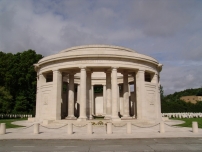| First Name: | Paul | Last Name: | HEANEY | |
|---|---|---|---|---|
| Date of Death: | 21/10/1914 | Lived/Born In: | Nunhead | |
| Rank: | Second Lieutenant | Unit: | Royal Lancaster1 | |
| Memorial Site: | Ploegsteert Memorial | |||
Current Information:Age-37 Disringuished Conduct Medal 11, Ansdell Road, Nunhead
The Race to the Sea - September-October 1914 By the middle of September 1914, the Aisne battlefield had stagnated into trench warfare and in order to break this impasse, both sides tried to outflank each other in a general movement northwards. Moving up through Picardy, Artois and Flanders the race was over by 19th October when the North Sea was reached. The Western Front, a line of trenches stretching from Belgium to Switzerland, was now a reality. Initially it was the French army that conducted this movement whilst the British Expeditionary Force remained on the Aisne but by 6th October British reinforcements were needed to help beat off German attacks around Lille. They moved north and along with reinforcements from Britain, they took up new positions in Flanders, on the left of the Allied line and much closer to the Channel ports. The Battle of Armentières - 12th October-2nd November 1914 The official History pinpoints the battle of Armentières to a series of battles that took place between the river Douve and a line between Estaires and Foumers. It was part of the Race to the Sea and it determined the line of the Western Front in that sector. It was fought by III Corps which was made up of 4th and 6th Divisions plus 19Brigade) 12 Brigade of 4th Division arrived in the north from the Aisne front on 11th October and two days later, on 13th October, they were involved in an eastwards advance. The 1st Royal Lancaster battalion marched for six miles and then attacked the village of Meteren but were unable to capture it. On 15th October 4th Division resumed the advance towards the Lys again and by the night 17/18th October had occupied Armentières & Houplines with 12 Brigade continuing the line to Le Gheer. At 6.30am on 18th October, 4th Division moved forward towards Frélinghien with 12 Brigade advancing along both banks of the River Lys towards their objective, the village of Le Touquet. The German front line in front of Lille did not run straight north as presumed at first but turned west at Verlinghem and ran to Frélinghien before continuing north along the river. This meant that the attack was bound to be enfiladed from the main enemy front line as indeed it was. With 1st Royal Lancaster and 2nd Lancashire Fusiliers leading, 12 Brigade reached the railway without meeting resistance but once across it came under heavy fire from front and flank. Nevertheless their attack continued and eventually nearly all of Le Touquet had been captured. The next day was a relatively quiet one during which C Company moved forward to an advanced position. But their stay there was short lived when, after an enemy attack all along the line, they were forced back to their original position. At 5.15 am on 21st October the Germans made a strong attack in the mist along the front of 12 Brigade, 4th Division, near Le Gheer, not far from Ploegsteert Wood. 1st Royal Lancaster and 2nd Lancashire Fusiliers held them off but to their left, 2nd Royal Inniskilling Fusiliers were forced back 400 yards. All the officers of one company of 2nd Royal Inniskilling Fusiliers were killed so Paul Heaney volunteered to help them and was immediately killed. He had just been promoted from the ranks to Second Lieutenant. |
||||
| « Back to Search Results | ||||
| If you think any of the information shown here is incorrect, Click Here to submit your amends and comments | ||||




